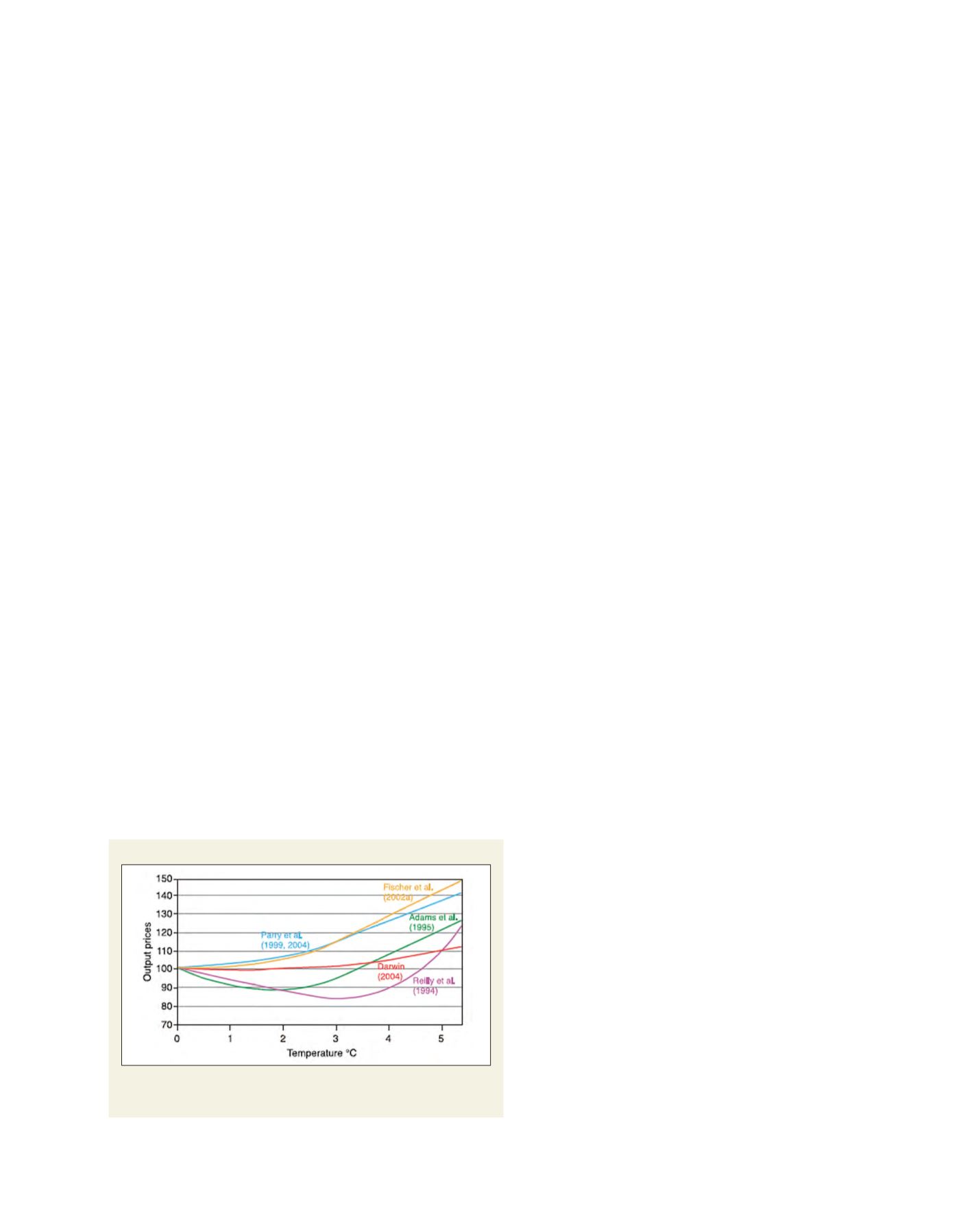

[
] 41
T
he
I
mpacTs
and
I
mplIcaTIons
of
c
lImaTe
c
hange
and
V
arIabIlITy
often occur through the indirect effects of the event acting via a break-
down in the means to distribute food through normal channels.
Food safety can also be threatened by climate change. Higher
temperatures increase the need for careful storage, and extreme
events pose a threat through increased risk of contamination by
water-borne disease during flooding or an increase in crop storage
pests and diseases. Moreover, if human livelihoods and incomes are
affected through a major extreme weather event, this could impact
on food affordability and therefore security.
Challenges in forecasting climate change impacts on food security
Past increases in greenhouse gas concentrations have caused detect-
able warming which has yet to be fully realized, so further warming
can confidently be predicted irrespective of whether emissions are
cut significantly in the next few years. Global mean temperatures
are expected to rise by between approximately 0.5 to 2.0°C by
2050, with regional land temperatures rising more rapidly in most
areas. Working Group 2 of the Intergovernmental Panel on Climate
Change concluded that global crop production will be threatened
by +1°C of warming and begin to decline at +3°C.
20
Direct consequences of warming, such as increased heat stress and
increases in mean sea level are therefore inevitable, although the rates
of such changes and local impacts are less certain. While warming
is also expected to increase global average precipitation, long-term
precipitation changes at regional scales are far more difficult to
confidently predict, especially in the next few years to decades when
year-to-year variability remains an important factor, before being over-
ridden by major human-induced climate change. Some level of skill
in model forecasts of decadal climate change has been demonstrated
at the global scale,
21
and at smaller scales in some regions, especially
the tropics, but considerable improvements in climate modelling are
required before long-term plans can be confidently supported.
The complex interactions between different impacts of climate change
also increase the difficulty of forecasting, withmuch agricultural produc-
tivity depending not only on local change but also other areas via factors
such as glacier melt, river flows and sea-level rise. The extent to which
these changesmay be counteracted or magnified by other influences such
as CO
2
fertilization, O
3
damage and changes in pests and diseases is also
not yet predictable with confidence. Identification of the key drivers of
major impacts will be important. An ability to assess changes in the risk of
extreme events will be key. The influence of ongoing trends
in average conditions may be overridden by a single major
extreme event that affects distribution of food across a wide
area. Considerable work is currently underway to improve
regional-scale monthly to decadal forecasting, especially of
the likelihood of extreme events.
22
Adapting food systems to climate change
The main issues will be the rapidity of change and
consequent lag in adaptation (human and technologi-
cal), together with the vulnerability of food crops to
extremes. With severe limitations on the ability to fore-
cast many aspects of climate change impacts at the scales
required, adaptation measures in the short- to medium-
term will need to focus on reducing vulnerability. This
can be achieved using a number of approaches, including
increasing productivity and improving distribution.
23
Increased crop productivitymay be achieved through the
selection of cultivars with traits that facilitate greater resil-
ience, such asmore efficient water use, and greater tolerance
to temperature extremes, pests and diseases. Changes in
management tools and techniques such as irrigation may
also assist with adaptation to shifting mean climate states.
Implementation of such adaptationwill require that climatic
changes be discernible enough to prompt action but gradual
enough to give adequate response time, or forward planning
on the basis of future risk assessment.
Reducing the vulnerability of individual farms’
productivity to extreme events may be particularly
challenging – for example, it has been suggested
24
that
small farmers in Amazonia often lack the long-term
knowledge and information on climatic extremes to
cope with unusual events such as the 2005 drought.
Improved food security may therefore require inter-
vention by local or national government. Adaptation of
post-production aspects of food systems may be needed,
such as improving the resilience of food distribution
infrastructure and communications.
In part this will require adaptation to climate change,
but given that resilience is already poor in many areas,
improving the ability to cope with existing climate vari-
ability is also needed. Some extreme events are relatively
localized, so food security can be enhanced by improv-
ing distribution networks to ensure that impacts on local
productivity are mitigated by access to production else-
where. This development must take account of potential
change, to ensure improved resilience is maintained.
While regional-scale decadal forecasting is still verymuch
in its infancy, seasonal forecasts in some regions such as
Ghana and northeast Brazil are already demonstrating
predictive skill due to improved understanding and model-
ling of links between regional weather and sea surface
temperatures. There is therefore some scope for the use of
seasonal climate forecasting as an adaptation tool, facilitat-
ing early warnings of impacts on food production. While
there are still many improvements to be made in the scien-
tific capability of seasonal and decadal forecasting, there is
also considerable scope for improved pull-through of such
forecasts to a wider range of actions on the ground.
Effects of climate change on cereal prices
Projected cereal prices (per cent of baseline) versus global mean temperature
change. Prices interpolated from point estimates of temperature effects
Source: Easterling et al. (2007). Copyright IPCC
















